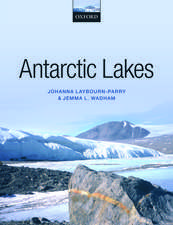European Large Lakes: Ecosystem changes and their ecological and socioeconomic impacts: Developments in Hydrobiology, cartea 199
Editat de Tiina Nõges, Reiner Eckmann, Külli Kangur, Peeter Nõges, Anu Reinart, Gulnara Roll, Heikki Simola, Markku Viljanenen Limba Engleză Hardback – 27 mar 2008
| Toate formatele și edițiile | Preț | Express |
|---|---|---|
| Paperback (1) | 952.57 lei 43-57 zile | |
| SPRINGER NETHERLANDS – 23 noi 2010 | 952.57 lei 43-57 zile | |
| Hardback (1) | 959.19 lei 43-57 zile | |
| SPRINGER NETHERLANDS – 27 mar 2008 | 959.19 lei 43-57 zile |
Din seria Developments in Hydrobiology
- 18%
 Preț: 1229.10 lei
Preț: 1229.10 lei - 18%
 Preț: 959.98 lei
Preț: 959.98 lei - 18%
 Preț: 963.91 lei
Preț: 963.91 lei - 15%
 Preț: 648.24 lei
Preț: 648.24 lei - 15%
 Preț: 637.89 lei
Preț: 637.89 lei -
 Preț: 378.23 lei
Preț: 378.23 lei - 15%
 Preț: 644.95 lei
Preț: 644.95 lei - 18%
 Preț: 952.09 lei
Preț: 952.09 lei - 20%
 Preț: 558.87 lei
Preț: 558.87 lei - 18%
 Preț: 1833.65 lei
Preț: 1833.65 lei -
 Preț: 393.59 lei
Preț: 393.59 lei -
 Preț: 406.54 lei
Preț: 406.54 lei - 18%
 Preț: 1226.73 lei
Preț: 1226.73 lei - 18%
 Preț: 956.99 lei
Preț: 956.99 lei -
 Preț: 388.87 lei
Preț: 388.87 lei - 24%
 Preț: 1060.51 lei
Preț: 1060.51 lei - 18%
 Preț: 1229.28 lei
Preț: 1229.28 lei - 20%
 Preț: 569.30 lei
Preț: 569.30 lei -
 Preț: 368.79 lei
Preț: 368.79 lei - 24%
 Preț: 817.46 lei
Preț: 817.46 lei - 18%
 Preț: 958.25 lei
Preț: 958.25 lei - 18%
 Preț: 953.03 lei
Preț: 953.03 lei -
 Preț: 384.75 lei
Preț: 384.75 lei - 24%
 Preț: 1582.91 lei
Preț: 1582.91 lei - 24%
 Preț: 1051.68 lei
Preț: 1051.68 lei - 18%
 Preț: 943.57 lei
Preț: 943.57 lei - 18%
 Preț: 1235.76 lei
Preț: 1235.76 lei - 24%
 Preț: 800.02 lei
Preț: 800.02 lei - 24%
 Preț: 803.55 lei
Preț: 803.55 lei - 18%
 Preț: 948.29 lei
Preț: 948.29 lei
Preț: 959.19 lei
Preț vechi: 1169.74 lei
-18% Nou
Puncte Express: 1439
Preț estimativ în valută:
183.54€ • 192.14$ • 151.87£
183.54€ • 192.14$ • 151.87£
Carte tipărită la comandă
Livrare economică 07-21 aprilie
Preluare comenzi: 021 569.72.76
Specificații
ISBN-13: 9781402083785
ISBN-10: 1402083785
Pagini: 276
Ilustrații: VII, 276 p.
Dimensiuni: 203 x 276 x 18 mm
Greutate: 0.84 kg
Ediția:2008
Editura: SPRINGER NETHERLANDS
Colecția Springer
Seria Developments in Hydrobiology
Locul publicării:Dordrecht, Netherlands
ISBN-10: 1402083785
Pagini: 276
Ilustrații: VII, 276 p.
Dimensiuni: 203 x 276 x 18 mm
Greutate: 0.84 kg
Ediția:2008
Editura: SPRINGER NETHERLANDS
Colecția Springer
Seria Developments in Hydrobiology
Locul publicării:Dordrecht, Netherlands
Public țintă
ResearchCuprins
Climate Change and Anthropogenic Impacts on Large Lakes Ecosystems.- Nutrients and phytoplankton in Lake Peipsi during two periods that differed in water level and temperature.- Pollen, diatom and plant macrofossil assemblages indicate a low water level phase of Lake Peipsi at the beginning of the Holocene.- Water level changes in a large shallow lake as reflected by the plankton:periphyton-ratio of sedimentary diatoms.- Changes in spatial distribution of phosphorus and nitrogen in the large north-temperate lowland Lake Peipsi (Estonia/Russia).- Recent trends in Lake Ladoga ice cover.- History of anthropogenically mediated eutrophication of Lake Peipsi as revealed by the stratigraphy of fossil pigments and molecular size fractions of pore-water dissolved organic matter.- Seasonality and trends in the Secchi disk transparency of Lake Ladoga.- Silicon load and the development of diatoms in three river-lake systems in countries surrounding the Baltic Sea.- Critical N:P ratio for cyanobacteria and N2-fixing species in the large shallow temperate lakes Peipsi and Võrtsjärv, North-East Europe.- Phytoplankton nitrogen demand and the significance of internal and external nitrogen sources in a large shallow lake (Lake Balaton, Hungary).- Changes in the water level of Lake Peipsi and their reflection in a sediment core.- Rates of change in physical and chemical lake variables — are they comparable between large and small lakes?.- Increasingly ice-free winters and their effects on water quality in Sweden’s largest lakes.- Phosphorus fractions and alkaline phosphatase activity in sediments of a large eutrophic Chinese lake (Lake Taihu).- Food Web Interactions and Dynamics in Large Lakes.- The impact of the invasive Ponto-Caspian amphipod Pontogammarus robustoides on littoralcommunities in Lithuanian lakes.- Spatiotemporal and long-term variation in phytoplankton communities in the oligotrophic Lake Pyhäjärvi on the Finnish-Russian border.- Plant-associated invertebrates and hydrological balance in the large volcanic Lake Bracciano (Central Italy) during two years with different water levels.- A comparison of zooplankton densities and biomass in Lakes Peipsi and Võrtsjärv (Estonia): rotifers and crustaceans versus ciliates.- Modeling Tools in Large Lakes Research.- Validation of the MERIS products on large European lakes: Peipsi, Vänern and Vättern.- Relations of phytoplankton in situ primary production, chlorophyll concentration and underwater irradiance in turbid lakes.- Models as tools for understanding past, recent and future changes in large lakes.- The ice cover on small and large lakes: scaling analysis and mathematical modelling.- Effects of warmer world scenarios on hydrologic inputs to Lake Mälaren, Sweden and implications for nutrient loads.- Variability of bio-optical parameters in two North-European large lakes.- Contributions of DOC from surface and groundflow into Lake Võrtsjärv (Estonia).- Water Policy and Socioeconomic Aspects of Large Lake Management.- Implications of flexibility in European Community environmental law: exemptions from environmental objectives in the Water Framework Directive.- Analysis of long-term ecological status of Lake Balaton based on the ALMOBAL phytoplankton database.- Towards ecological goals for the heavily modified lakes in the IJsselmeer area, The Netherlands.- Environmental awareness of the permanent inhabitants of towns and villages on the shores of Lake Balaton with special reference to issues related to global climate change.- Highlights of large lake research and management inEurope.
Textul de pe ultima copertă
Large lakes are important because of their size and ecological distinctiveness as well as their economic and cultural value. Optimal management of them requires a proper understanding of anthropogenic impacts both on the lake ecosystems as such and on the services they provide for society. The specific structural and functional properties of large lakes, e.g. morphology, hydrography, biogeochemical cycles and food-web structure, are all directly related to their size. Although large lakes are among the best-studied ecosystems in the world, the application to them of environmental regulations such as the European Water Framework Directive is a challenging task and requires that several natural and management aspects specific to these water bodies are adequately considered. These vulnerable ecosystems often suffer from accelerated eutrophication, over-fishing, toxic contamination and invasive species. Large lakes offer socio-economic benefits and can be used in many ways, and are often areas in which economic, cultural and political interests overlap. In this book the problems regarding the present status of European large lakes and the directions of change are discussed. Threats caused by direct human impact and by climate change, protection needs and restoration measures are considered.
Caracteristici
Presents comprehensive highlights of large lake research and management in Europe Considers climate change and anthropogenic impacts on large lake ecosystems Reviews food web interactions and dynamics in large lakes












